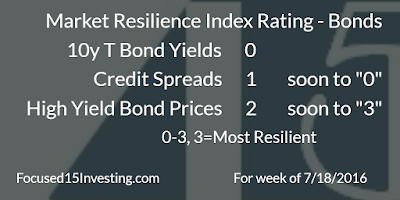In the
sections that follow, I provide an update on Market Resilience Index (MRI) for
key asset classes.
The
ratings range from 0-3, with 3 being the highest. The symbol “^” means that the rating is
likely to move higher (becoming more resilient). They symbol “v” means the rating is likely to
move lower (becoming more vulnerable).
Sections
US Bonds
Developed Market Stocks
Commodities
Emerging Stocks and Bonds
The
tables in each section detail the current and prior week ratings; the
accompanying text reflects the updated outlook.
US Bonds
Market
Resilience Index Ratings
|
For Week of…
|
7/25/2016
|
7/18/2016
|
|
US 10y Treasury yield
|
0
|
0
|
|
US 10y Treasury futures
|
2
|
3
|
|
Credit spreads
|
0
|
1 v
|
|
High yield bond prices
|
3
|
2 ^
|
With a 0
rating on the resilience scale, the US 10y Treasury yield is vulnerable to
declines. I expect this condition to remain in place for the next few weeks.
By the same
token, US 10y Treasury bond prices display strong resilience, although the
rating for the futures counterpart (TY1) has fallen to 2 this week. Near term, resilience
is abating and prices may ease slightly. That said, the market does not appear
especially vulnerable now, suggesting any decline will be moderate.
Credit
spreads–US corporate BBB less 10y Treasury yields–are currently rated 0, down
from 1 in the prior week, as anticipated, suggesting that spreads will narrow.
Consistent
with the above, US high yield bonds are now rated 3, or highly resilient, up
from 2 previously, again as expected. All else being equal, prices will tend to
rise.
Bottom
line: US bonds, in general, and high yield issues, in particular, will remain
attractive investments over the next few weeks.
Developed Market Stocks
Market
Resilience Index Ratings
|
For Week of…
|
7/25/2016
|
7/18/2016
|
|
DJ Industrial stocks
|
2 ^
|
2 ^
|
|
DJ Transportation stocks
|
1 ^
|
1 ^
|
|
European stocks (SPE)
|
1
|
0
|
|
Japanese stocks (TPX)
|
1 ^
|
0 ^
|
With a rating
of 2, US stocks, as represented by the Dow Jones Industrial Average, display moderate
resilience, suggesting that prices will tolerate negative news and events
reasonably well in the near term.
European
stock prices have a rating of 1, up from 0 the prior week. While more vulnerable than the DJ Industrial
stocks, they are finding more resilience.
Some elements of resilience are cyclical and a key European stock
resilience force is nearing a low in its cycle. Consequently, we may see a rating
upgrade over the next month or so.
Japanese
stocks also have a 1 rating, up from 0 the prior week. That said, they are closer to experiencing a
shift to a higher rating than are European stocks.
Bottom
line: Overweight US Industrial stocks, underweight European and Japanese
stocks.
Commodities
Market
Resilience Index Ratings
|
For Week of…
|
7/25/2016
|
7/18/2016
|
|
SPGSCI
|
2
|
2
|
|
Crude oil (WTI )
|
2
|
2
|
|
Gold
|
3
|
3
|
|
Copper
|
3
|
3
|
Overall,
commodity prices remain resilient.
The
S&P Goldman Sachs Commodity index represents a basket of commodities, with
a high weighting in crude oil. The SPGSCI has a rating of 2, down from 3
previously over the last few weeks, reflecting the fact that oil prices appear vulnerable
on a short-term basis. However, this looks to be a short-term breather to price
increases rather than a fundamental shift in longer-term resilience.
Gold and
copper, meanwhile, continue to be resilient, with ratings of 3 for both. Prices
may soften near term, but longer-term resilience forces remain decidedly
positive for the two metals.
Bottom
line: Overweight commodities, in general, and gold and copper, in particular.
Emerging Markets
Market
Resilience Index Ratings
|
For Week of…
|
7/25/2016
|
7/18/2016
|
|
EM stocks (MSCI MXEF)
|
3
|
3
|
|
EM bonds (FNMIX)
|
3
|
3
|
Emerging
market stock and bond prices continue to be resilient. EM stocks and bonds, represented by the MSCI
Emerging Markets Index and a popular EM bond mutual fund, respectively, have ratings
of 3.
In both
cases, longer-term resilience forces are robust–and decidedly so. I expect this
condition to remain in effect for several weeks. They
will likely tolerate negative news and events fairly well.
Plausible Narrative
A
plausible narrative that makes accommodates the broad set of MRI ratings across
asset classes goes like this...
Despite
positive signs in the US, the global economy is struggling. There is high uncertainty about the political
situations in the US, UK, and Europe. The
best quick-fix remedy for all our ills is a mix of low interest rates, calming
voices from the Federal Reserve’s Janet Yellen and her counterparts around the
world. The US Fed has the strongest medicine globally, and it is needed.
However, the US is in the least need of the medicine. Therefore, we in the US
will benefit from the strong medicine being administered globally, and benefit
more than we alone need. For the time being, this will result in greater
resilience for US stocks and bonds.
Please
note:
- The disciplined analysis of market resilience drives this narrative
- Other narratives may also be plausible
- When the bottom-up resilience data suggests a change in the narrative, that change will be made
- The narrative does not affect the analysis of market resilience or the target weights in the model portfolios
Focused
15 Investing model portfolios positioned according to a wide range of MRI
ratings. However, the guideline is consistent
across all markets – overweight the resilient, underweight the vulnerable.
Please
contact me with questions or comments in the tab above.







